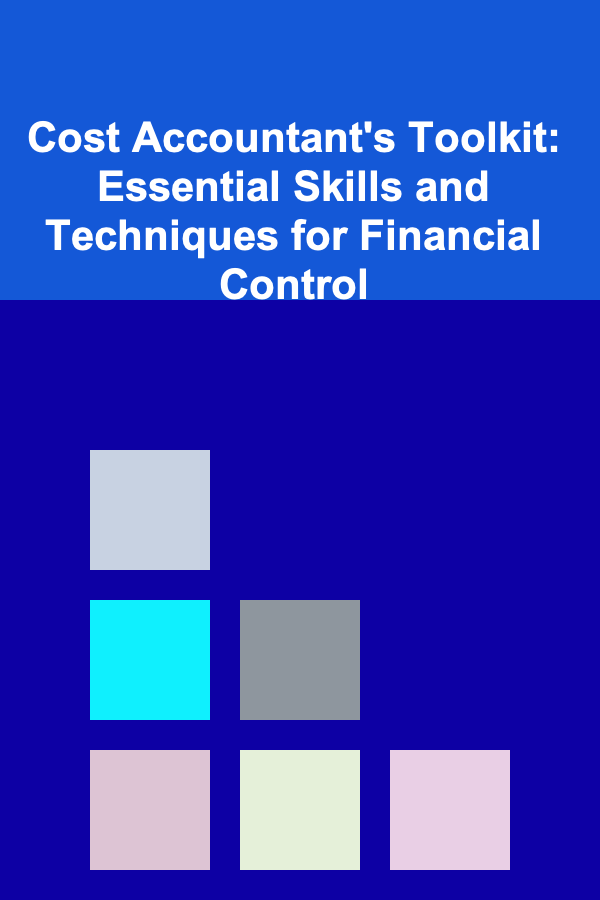
Cost Accountant's Toolkit: Essential Skills and Techniques for Financial Control
ebook include PDF & Audio bundle (Micro Guide)
$12.99$11.99
Limited Time Offer! Order within the next:

Cost accounting plays a pivotal role in helping businesses optimize their financial health, ensuring that they stay competitive in their respective markets. As organizations face increasing complexity in their operations, the role of the cost accountant has evolved to become central to financial control. To provide effective support to management, cost accountants need a set of essential skills and techniques that enable them to manage costs, analyze financial data, and provide strategic insights that drive better decision-making.
This comprehensive guide delves into the essential skills and techniques every cost accountant should have in their toolkit for effective financial control. By mastering these tools, cost accountants can contribute significantly to the financial stability and growth of the organization.
Mastery of Costing Methods
A solid understanding of costing methods is foundational for any cost accountant. Different organizations require different costing approaches based on their production processes, product types, and industry standards. Below are some critical costing methods that every cost accountant should be proficient in:
1.1 Job Order Costing
Job order costing is ideal for businesses that produce products based on specific customer orders or custom specifications. It assigns costs to individual jobs or orders, making it particularly useful for industries like construction, custom manufacturing, and consulting.
Key Skills for Job Order Costing:
- Tracking Direct Costs: Accurately assigning direct materials, direct labor, and overhead costs to specific jobs or projects.
- Job Cost Sheets: Creating and maintaining job cost sheets to record all costs related to a particular job, allowing for detailed tracking and analysis.
- Cost Allocation: Understanding how to allocate indirect costs (overhead) to jobs based on appropriate cost drivers.
1.2 Process Costing
Process costing is used by organizations that produce homogeneous products in a continuous production process, such as food manufacturers or chemical producers. This method assigns costs to processes or departments rather than individual jobs.
Key Skills for Process Costing:
- Cost Flow Assumptions: Applying appropriate cost flow assumptions such as FIFO (First In, First Out) or Weighted Average to manage the costs of materials and conversion costs.
- Cost Per Unit Calculation: Knowing how to calculate unit costs for large-scale, homogeneous production runs, and understanding the flow of costs through production processes.
- Cost Monitoring: Tracking and analyzing the efficiency of each process, identifying inefficiencies, and suggesting improvements.
1.3 Activity-Based Costing (ABC)
Activity-Based Costing (ABC) offers a more detailed and accurate approach to cost allocation by associating costs with the activities that generate them. This method is particularly useful in complex environments where indirect costs make up a significant portion of total costs.
Key Skills for ABC:
- Identifying Activities: Identifying and analyzing the various activities within an organization that incur costs (e.g., machine setups, quality control, procurement).
- Determining Cost Drivers: Understanding how specific activities consume resources and identifying cost drivers (e.g., number of setups, hours of inspection).
- Cost Allocation: Allocating overhead based on the actual consumption of resources by each product or service, providing a more accurate picture of profitability.
Financial Analysis and Reporting Skills
Cost accountants need to be adept at analyzing and reporting financial data in ways that provide actionable insights to management. These skills ensure that they can evaluate cost structures, identify areas for improvement, and communicate their findings clearly to stakeholders.
2.1 Variance Analysis
Variance analysis is one of the most important techniques in cost accounting. It helps cost accountants compare actual costs to standard costs and analyze the reasons behind any discrepancies. Variance analysis is crucial for identifying inefficiencies, monitoring performance, and controlling costs.
Key Skills for Variance Analysis:
- Material Variance: Analyzing the difference between the actual and expected cost of materials, including material price and usage variances.
- Labor Variance: Evaluating labor variances, including differences in labor rates and efficiency.
- Overhead Variance: Analyzing fixed and variable overhead variances, and determining the causes behind them.
2.2 Break-even Analysis
Break-even analysis is a critical tool used by cost accountants to determine the point at which an organization's revenues equal its costs. This analysis helps businesses understand the minimum sales required to avoid losses and informs pricing and production decisions.
Key Skills for Break-even Analysis:
- Calculating Break-even Point: Determining the sales volume at which total revenue equals total fixed and variable costs.
- Margin of Safety: Understanding how much sales can decline before the company reaches its break-even point.
- Cost-Volume-Profit (CVP) Analysis: Using CVP analysis to evaluate how changes in costs, production levels, and prices impact profitability.
2.3 Budgeting and Forecasting
Effective budgeting and forecasting are crucial for cost accountants in providing management with the necessary tools for planning and controlling financial performance. Budgeting involves setting financial goals for a future period, while forecasting involves predicting future costs and revenues.
Key Skills for Budgeting and Forecasting:
- Creating Flexible Budgets: Developing flexible budgets that can adapt to changes in activity levels, such as production volume or sales.
- Forecasting Techniques: Using statistical methods and historical data to forecast future costs, revenues, and capital expenditures.
- Variance Analysis for Budgets: Analyzing variances between actual performance and budgeted figures to assess the effectiveness of financial planning.
Cost Control Techniques
Cost control is an ongoing process that involves monitoring and managing an organization's costs to ensure they remain within budget and align with financial goals. Cost accountants play a crucial role in identifying areas where costs can be reduced without affecting product quality or operational efficiency.
3.1 Standard Costing
Standard costing is a technique used to assign predetermined costs to products, based on the expected usage of materials, labor, and overhead. By comparing actual costs to standard costs, cost accountants can quickly identify discrepancies and take corrective actions.
Key Skills for Standard Costing:
- Setting Standard Costs: Understanding how to establish standard costs for materials, labor, and overhead, based on historical data or industry benchmarks.
- Tracking and Reporting: Regularly comparing actual costs with standard costs and preparing reports on variances.
- Corrective Actions: Recommending corrective actions for any unfavorable variances, such as process improvements or renegotiating supplier contracts.
3.2 Just-in-Time (JIT) Inventory Management
Just-in-Time (JIT) is a cost control system that aims to minimize inventory levels by ordering materials only when needed in the production process. JIT reduces inventory holding costs and increases cash flow efficiency.
Key Skills for JIT:
- Inventory Planning: Ensuring that raw materials and components are delivered exactly when needed, minimizing stockouts and overstocking.
- Supplier Relations: Managing relationships with suppliers to ensure timely deliveries and favorable pricing.
- Cost Monitoring: Tracking inventory turnover and identifying areas where JIT can reduce carrying costs and improve operational efficiency.
3.3 Value Engineering (VE)
Value Engineering is a systematic method for improving the "value" of a product or service by analyzing its functions and finding ways to reduce costs while maintaining or improving its quality.
Key Skills for Value Engineering:
- Function Analysis: Understanding the essential functions of a product and identifying opportunities to reduce unnecessary costs while maintaining quality.
- Cost Optimization: Identifying alternative materials, processes, or designs that can reduce production costs.
- Cross-functional Collaboration: Working with design, engineering, and procurement teams to develop cost-effective solutions.
Advanced Technological Proficiency
In today's digital age, cost accountants must leverage technology to perform their tasks more efficiently and accurately. Advanced software tools and data analytics are transforming the field of cost accounting, making it easier to track, analyze, and report on financial data.
4.1 Enterprise Resource Planning (ERP) Systems
ERP systems integrate various business functions, including cost accounting, into a unified platform. Cost accountants must be proficient in using ERP software to manage financial data, track costs, and generate reports.
Key Skills for ERP Systems:
- ERP Navigation: Understanding how to navigate and utilize ERP software to retrieve and input data, and generate reports.
- Data Integration: Ensuring that cost accounting data is accurately integrated with other business functions like inventory, purchasing, and sales.
- Customization: Customizing ERP reports to reflect specific cost analysis needs, ensuring that cost data is presented in a user-friendly format.
4.2 Data Analytics
Data analytics allows cost accountants to extract actionable insights from large datasets, enabling more informed decision-making. The use of data analytics tools like Power BI or Tableau helps accountants visualize trends, forecast future costs, and identify cost-saving opportunities.
Key Skills for Data Analytics:
- Data Manipulation: Understanding how to work with large datasets to clean, transform, and analyze cost-related information.
- Visualization: Using data visualization tools to present complex financial data in easy-to-understand formats, making it accessible for management decision-making.
- Predictive Analytics: Utilizing predictive modeling techniques to forecast future costs and trends, helping the organization prepare for financial challenges.
Conclusion
A cost accountant's toolkit is diverse and multifaceted, requiring expertise in a variety of techniques and skills to ensure effective financial control. Mastery of costing methods, financial analysis, cost control, and modern technological tools enables cost accountants to provide invaluable support to businesses. By continuously refining these skills, cost accountants can contribute significantly to the success and profitability of the organizations they serve, driving more informed decision-making and better financial outcomes.

How to Master Coffee Cupping and Tasting
Read More
How to Stage Your Home's Basement to Maximize Usable Space
Read More
Top Tips for Lowering Business Insurance Premiums and Reducing Operational Costs
Read More
Mastering the Art of Quick Spot Cleaning with Handheld Vacuums
Read More
How to Build Healthy Habits for Mental Well-being
Read More
Finding Books That Play with Narrative Structure
Read MoreOther Products

How to Master Coffee Cupping and Tasting
Read More
How to Stage Your Home's Basement to Maximize Usable Space
Read More
Top Tips for Lowering Business Insurance Premiums and Reducing Operational Costs
Read More
Mastering the Art of Quick Spot Cleaning with Handheld Vacuums
Read More
How to Build Healthy Habits for Mental Well-being
Read More